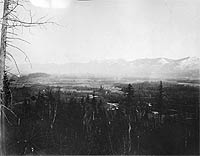
"Well, when the time comes, the flood started. They began to follow the Sumas Mountain. The Indian calls that mountain Kw'ekw'e'Rqw. That was the name of the mountain that didn't go out of sight during that flood. Well, they got up to the top of the mountain, and they had a long rope that the Indians work, braided of some kind of skin and trees, and they up themselves there. The story said there's three canoes went lost from there, that broked off and nobody knows where they went to."
"For so many days they were up there; then the water began to come down. They got down, about halfway down, to the lower land. They stopped in a place, and there's a cove into the mountain. So they stay there, right there, to be dry. And they had that long rope coiled up inside that cave. And they stayed there, those people, stayed right there. They could see the lower land was dry. The grass began to get green. Then they began to come down. And that long rope and other stuffs that they had there, that's left there. Anybody can see that coil of rope inside that cave. Whoever will see it, it will be either good luck or bad luck, whoever will see the coil of rope and the stuff that's left in there. And then they began to come down. They got down there, and the place was all dry.
(Wells, Oliver N., The Chilliwacks and Their Neighbors, ed. Ralph Maude, Brent Galloway and Marie Weeden. Vancouver; Talonbooks. P. 88, Dan Milo recounting the Flood story)
Descriptions by colonial settlers describe the physical beauty but usually within the context of altering or changing the landscape to suit development needs.
"At present I have only been here about 5 days and have been working hard all the time clearing away the thick brush and building a shanty. The scenery is most lovely but as far as I have seen the place abounds in snakes, mosquitoes, sand flies, rain, thunder with an occasional roasting day of 113 degrees…The prairie runs down to the bank of the Chilukweyuk from which we are about 2 miles distant, the view from the camp is superb, the prairie in front with its beautiful waving grass and belts of poplar, willow, ash and maple in the foreground....There are plenty of bear and deer about us and beaver about 25 miles off."
(Stanley, George, editor, Mapping the Frontier, Lt. Charles Wilson's Diary of the Survey of the 49th Parallel, 1858-1862, June 10 and 16, 1859, pages 48-50).
In the 1860s these differing viewpoints clashed. The clash occurred against the backdrop of rapidly declining populations within the Sto:lo, caused by newly introduced diseases such as smallpox. This meant that when reserves were introduced in 1867 there was very little resistance. The establishment of the reserves made it possible for the colonial settlers to begin the process of altering the landscape of the Chilliwack area, to create a farming community, somewhat modeled on the communities that many of the colonial settlers had left behind in Eastern Canada and the Eastern United States. The pace of the change was rapid and irreversible. It began with land clearing and slash burning.

Overhead view of valley from Chilliwack Mountain, ca. 1890s. P.Coll 81

A country view near Chilliwack, B.C. P1987 167 29
